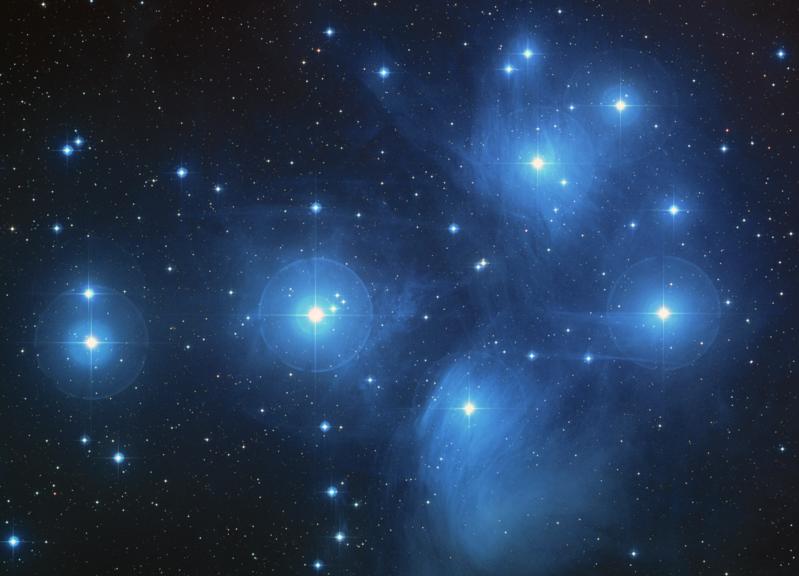Stellar Magnitude

Credit: HST/NASA
Light is the main signal we get from space. It is therefore important to be able to measure the brightness of stars and galaxies. If we can quantify how bright an object is, we can compare it with other objects. It also lets us work out whether the brightness of an object changes over time.
The Magnitude Scale
The magnitude of an astronomical object is simply a measure of its brightness. The magnitude unit of measurement is unusual. The lower (or more negative) the value, the brighter the object is.
Also, the scale is logarithmic, not linear. For example, a magnitude 1 star is not 2 times as bright as a magnitude 2 star. The difference in brightness between each magnitude is actually almost 2.512 times. This means that a star with a magnitude of 1 is 100 times brighter than a star with a magnitude of 6 (2.512 x 2.512 x 2.512 x 2.512 x 2.512 = 100)
Types of Magnitude
There are 2 types of stellar magnitude: absolute and apparent.
The absolute magnitude is how bright the object would be if it was a set distance from the Earth. A distance of 10 parsecs is used. A parsec is a distance unit used in astronomy. It is the same as 3.26 light years, or 31,000 billion kilometres (19,000 billion miles)! Absolute magnitudes let us compare the brightness of different objects.
The apparent magnitude is how bright the object appears to be from Earth. When objects get further away from Earth they appear fainter. A star more than 10 parsecs away from Earth will look fainter than its absolute magnitude. A star which is closer will be brighter than its absolute magnitude.
Measuring Magnitudes
The human eye can detect a difference of 1 magnitude quite easily. Smaller differences are much harder to see, needing a lot of practice. The night sky today is much harder to observe using only our eyes. Dim stars are often hard to see because of light pollution. Going somewhere far from towns and cities allows us to see many more stars.
CCDs on telescopes like the Liverpool Telescope can measure the number of photons detected. This value can be converted into an apparent magnitude or ‘instrumental magnitude’. Be aware that you can not directly compare this magnitude to those made by other people. This is because it depends on the instruments and software you used to measure it. In order to be able to compare your values with those of others, you must calibrate your results. This allows you to compare like with like. Calibration is usually carried out using a standard star.
Standard stars are stars which have had their magnitude measured very carefully by astronomers. You can measure the brightness of a standard star and use that information to work out the true magnitude of your object. It is then reasonable to compare your data with calibrated data collected by other people.
The Maths of the Magnitude System
The maths of magnitude can be summed up in the equation:
m1- m2 = -2.5 × log ( f1/ f2 )
m1 and m2 represent the magnitude of two stars and f1 and f2 represent their relative fluxes. Flux is the brightness divided by the area used to collect the light (usually the telescope aperture).
For example, imagine 2 stars visible in the night sky. One star is 100 times brighter than the other. This value of 100 represents the ratio of the fluxes (f1/ f2). Since the log of 100 is 2, we can say that m1- m2 = -2.5 × 2 = -5. This tells us that star 1 is 5 magnitudes brighter than star 2 (remember that the magnitude scale is inverse).
The History of the Magnitude Scale
The magnitude scale was invented by an Ancient Greek astronomer named Hipparchus. He gave the brightest stars a value of 1 and the dimmest stars he could see a value of 6.
Since the invention of better and better telescopes, the magnitude scale has had to be extended. We now know of objects much fainter than the naked eye limit of 6. We also include bright objects that have magnitudes less than 1. For example, the star Vega is given the value of zero. So an object brighter than Vega will have a negative and a fainter one will have a positive magnitude. Sirius, in Canis Major, is the brightest star in the night sky and has a magnitude of -1.5.
Examples of the Magnitude Scale
| Object | Magnitude | Comments |
| Sun | -27 | Very bright objects |
| Full Moon | -13 | |
| Venus (planet) | -4.4 | |
| Jupiter (planet) | -2.7 | |
| Sirius (brightest star in sky) | -1.5 | |
| Vega | 0.0 | Hipparchus's original brightness scale (1 to 6) |
| Betelgeuse (star in constellation of Orion) | 0.5 | |
| Saturn (planet) | 0.7 | |
| Regulus (star in constellation of Leo) | 1.3 | |
| Uranus (planet) | 5.5 | |
| Dimmest star seen with naked eye | 6 | |
| Pluto (dwarf planet) | 14 | Objects only seen through telescopes |
| Dimmest object observable the with Liverpool Telescope | 25 | |
| Hubble Telescope - Deep Field Observation | 30 |

